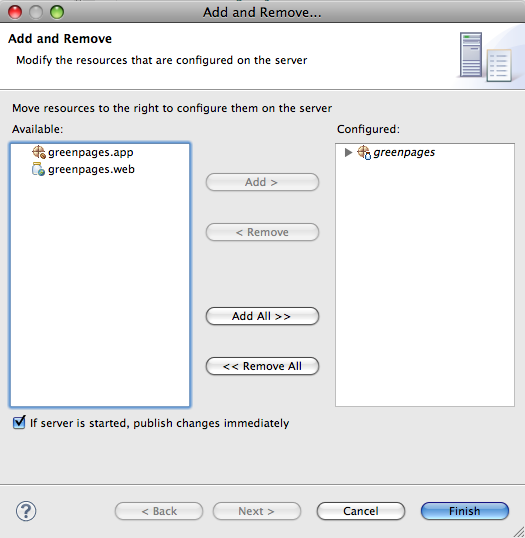In an OSGi-based application, the business logic behind a controller is typically accessed through the OSGi Service Registry.
By default, Bundlor detects and exports all packages in a bundle.
In this step Bundlor is told what to
export from the greenpages.app bundle and which types from those packages to use in the
greenpages.web bundle.
Add and save the following entry to the template.mf file in the
greenpages.app project and then run the MANIFEST.MF generation on the project as
explained in the section called “Creating web module metadata”.
Excluded-Exports: greenpages.internal
(As before, be careful not to leave trailing spaces on the ends of lines and not to add any blank lines to the file. The second line of this entry has a leading space—do not omit it.)
Check that the package is no longer exported in the greenpages.app MANIFEST.MF file
which should look something like this:
Manifest-Version: 1.0 Bundle-Name: GreenPages Service Bundle-ManifestVersion: 2 Bundle-Vendor: SpringSource Inc. Bundle-SymbolicName: greenpages Tool: Bundlor 1.0.0.M6 Export-Package: greenpages;version="2.0" Bundle-Version: 2.0
Go to the next step.
Now that the greenpages.app bundle exports the package that the
Directory and Listing interfaces reside in,
the greenpages.web bundle must import it.
In this step you will update the Maven
pom.xml file to depend on the greenpages.app bundle and import the
package.
Open the pom.xml file in the greenpages.web project.
(Edit the source directly by using the pom.xml tab in the editor.)
In this file add
the following entry (between the <dependencies> tags):
<dependency> <groupId>com.springsource.dmserver</groupId> <artifactId>greenpages.app</artifactId> <version>${project.version}</version> </dependency>
Open the GreenPagesController class and import the Listing and
Directory types.
(Eclipse should now offer these as a Quick Fix.
It it does not, set greenpages.app as a project dependency of greenpages.web
in the Build Path of the web project.)
The class should now compile cleanly.
The following imports should now have been added to the GreenPagesController class:
import greenpages.Directory; import greenpages.Listing; import java.util.List; import org.springframework.beans.factory.annotation.Autowired; import org.springframework.stereotype.Controller; import org.springframework.web.bind.annotation.RequestMapping; import org.springframework.web.bind.annotation.RequestParam;
Add the following package clause to the Import-Template entry in the
template.mf file in the greenpages.web project. When added run the
MANIFEST.MF generation on the project as described in the section called “Creating web module metadata”.
greenpages.*;version="[2.0, 2.1)"
Be careful to include the “.*” in the package pattern.
Once Bundlor has finished, go to the next step.
Currently the dm Server instance has a single web module bundle deployed. In this step, the
greenpages.web bundle is undeployed and greenpages PAR is deployed.
Right-click on the dm Server in the Servers view, and select
Add and Remove Projects…. In the dialog that opens, remove the
greenpages.web bundle and add the greenpages PAR to the server. When
the configuration is complete, press Finish.

Eclipse automatically undeploys the greenpages.web bundle and deploys the
greenpages PAR.
When this happens, the deployment may fail with an error.
If it does not, open the browser again at
http://localhost:8080/greenpages
and observe the failure which should have a root cause similar to:
org.springframework.beans.factory.NoSuchBeanDefinitionException:
No matching bean of type [greenpages.Directory] found for dependency:
expected at least 1 bean which qualifies as autowire candidate for this dependency.
Dependency annotations: {@org.springframework.beans.factory.annotation.Autowired(required=true)}
This error is caused by there being no instance of Directory to inject into the controller.
The next section will supply one.
There is no instance of Directory to be
injected into the controller.
In the GreenPages application, it is intended that this
implementation is used through an interface in
the OSGi Service Registry.
Using a service in the Service Registry enables
another bundle to
provide an implementation without revealing the implementation or the provider to all clients of the
service.
dm Server supports the use of the Spring DM namespace for
referencing elements in the OSGi Service Registry.
This step adds an OSGi Service Reference to an implementation of the
Directory interface.
In the webapp/WEB-INF/applicationContext.xml file in the greenpages.web
projects add a reference to a
greenpages.Directory instance in the OSGi service registry using
the <osgi:reference/> tag as follows:
<osgi:reference id="directory" interface="greenpages.Directory"/>
The tools will automatically redeploy the greenpages.web bundle when the change to the
bean definition has been saved.
The web bundle will not completely start.
After some time, the following error should occur:
<CC0001W> Mandatory reference '&directory' in bundle 'greenpages-1-greenpages.web' version '2.0.0' is waiting for service with filter '(&(objectClass=greenpages.Directory)(!(com.springsource.server.app.name=*)))'.
This error indicates that there is no provider of a greenpages.Directory in
the Service Registry. The next step will address this.
The error is re-issued as the dm Server instance waits for the service to be supplied. After about five minutes the server will “time-out” and the deploy will be abandoned. This same error (and time-out) will occur each time the PAR is redeployed as each change is made.
Stop the server instance by right-clicking on the server in the Servers view and selecting Stop. This will avoid unnecessary delays as changes are made.